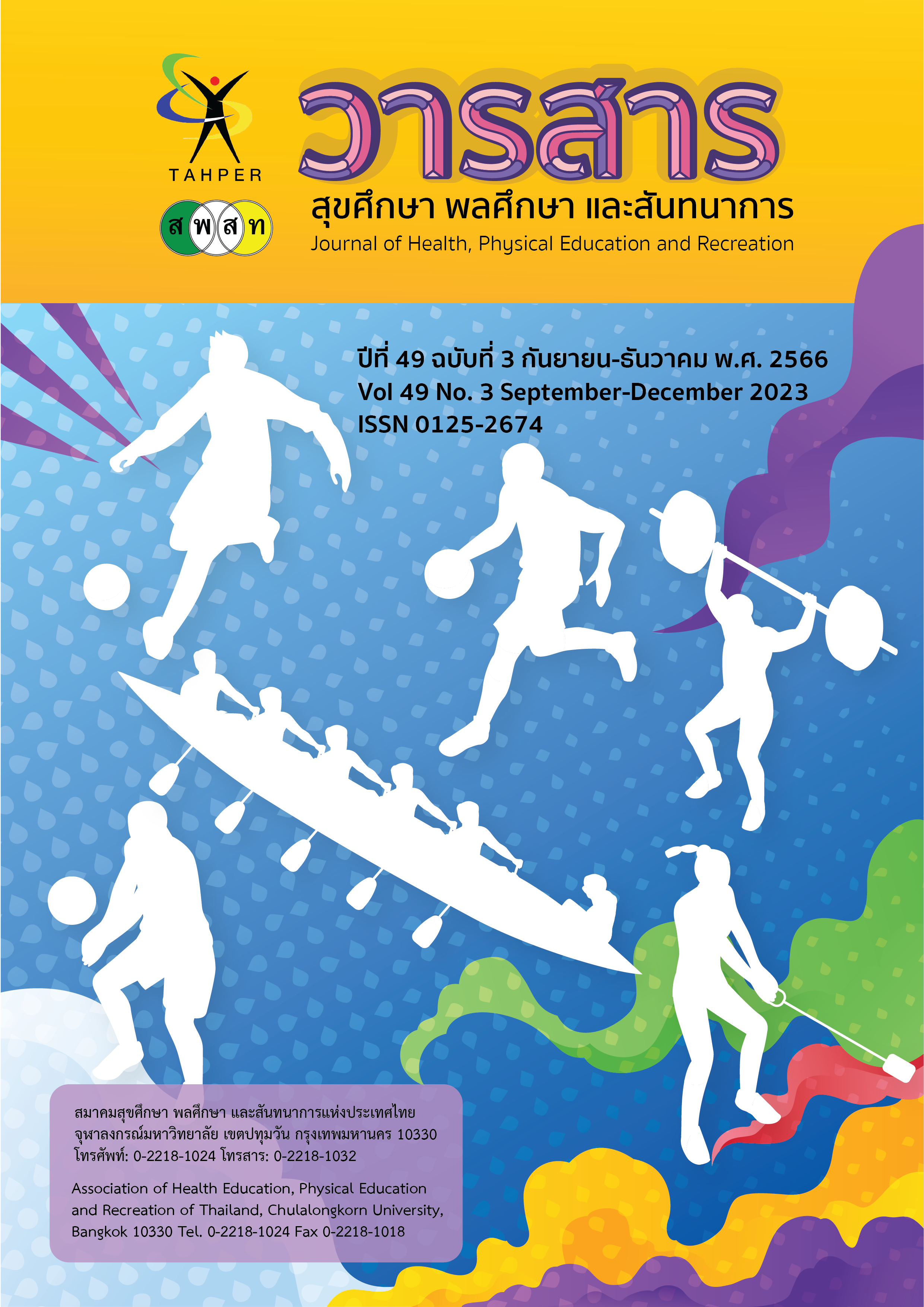Effect of Plong Exercise on Health-Related Physical Fitness of Mathayomsuksa 6 Female Students at Kongkaram School in Phetchaburi
Main Article Content
Abstract
The purpose of this study was to compare effects of Plong Exercise on health-related physical fitness of female students of Mattayomsuksa 6, Kongkaram School in Phetchaburi. The quasi-experimental design was used for this research. The population of the study was female students at Kongkaram School, Phetchaburi. The subjects were 30 Mattayomsuksa 6/5 female students in the first semester of the academic year 2019. The sample was selected using purposive sampling.
The instruments used were as follows: 1) The Plong Exercise program affecting health-related physical fitness of Mattayomsuksa 6 female students. The content validity was approved by 7 experts. The program was then assessed for and the research purpose by using Rovinelli and Hambleton’s method, which had an index of item objective congruence (IOC) ranging from 0.5-1.00. The training session lasted for 8 weeks, 3 days a week (Monday, Wednesday, Friday) during 7:30-8:30 hrs. 2) AAHPERD Health Related Physical Fitness Test. The data were analyzed and presented using means, standard deviations, Repeated Measures ANOVA and a pairwise comparison of the means by Bonferroni's method.
The study showed that, after 8 weeks of the Plong Exercise program with 4 components, health-related physical fitness of the subjects with regard to triceps and medial calf skinfold thickness (mm) to measure Body composition, as well as of Sit and Reach Test (centimeter) to measure flexibility was not significantly different at 0.5 level before the training, during the 4th week and after the 8th week of training. Meanwhile, health-related physical fitness with the 1.5 Mile run test (min.) to measure cardiovascular and respiratory endurance, and 60 seconds of sit-ups (times) to measure abdominal muscle strength and endurance during the 4th week and after the 8th week of training was improved, with a significant difference at 0.5 level.
Article Details

This work is licensed under a Creative Commons Attribution-NonCommercial-NoDerivatives 4.0 International License.
Critical thinking in journals is the right of the author. The Association of Health Education, Physical Education and Recreation of Thailand is not always required, to create diversity in ideas and creativity.
ความคิด ข้อวิพากษ์ในวารสารเป้นสิทธิของผู้เขียน สมาคมสุขศึกษา พลศึกษา และสันทนาการแห่งประเทศไทยไม่จำเป็นต้องเห็นชอบด้วยเสมอไป เพื่อให้เกิดความหลากหลายในความคิดและความสร้างสรรค์
References
กรมอนามัย กระทรวงสาธารณสุข. (2560). กรมอนามัยเผย คนไทยนั่งเนือยนิ่ง 14 ชม./วัน แนะเคลื่อนไหวร่างกายบ้าง. สืบค้นเมื่อ 12 มกราคม 2562, สืบค้นจากhttps://www.anamai.moph.go.th/ewt_news.php?nid=11150&filename=2016
กาญจนศรี สิงห์ภู่. (2550). คู่มือการออกกำลังกายเพื่อสุขภาพสำหรับประชาชน. สืบค้นเมื่อ 1 พฤษภาคม 2561, สืบค้นจาก http://healthcaredee-21.blogspot.com/2012/04/blog-post.html.
กิตติกา ธนะขว้าง และ รัตนากร ยศอินทร์. (2556). การออกกำลังกายด้วยการำไม้พลองประยุกต์กับการฟ้อนมองเชิงเมืองน่านต่อสมรรถภาพทางกายของผู้สูงอายุ. พยาบาลสาร, 40(2), 148-161.
เข็มพร วิรุณราพันธ์. (2561). เรียนหนัก-เนือยนิ่ง-ติดจอ ทำเด็กไทยสุขภาพแย่ ชี้ควรส่งเสริม เล่นอิสระ สร้างพัฒนาการ. สืบค้นเมื่อ 12 มกราคม 2562, สืบค้นจาก https://www.naewna.com/local/325056?fb_comment_id=1507913089319398_1508414162602624
เจริญ กระบวนรัตน์. (2552). การยืดเหยียดกล้ามเนื้อ. กรุงเทพฯ: คณะศึกษาศาสตร์ มหาวิทยาลัยเกษตรศาสตร์.
เจริญ กระบวนรัตน์. (2557). วิทยาศาสตร์การฝึกสอนกีฬา. กรุงเทพฯ: บริษัทสินธนาก๊อปปี้เซ็นเตอร์ จำกัด.
ชาญชัย ขันติศิริ. (2563). เอกสารประกอบการสอนวิชาวิทยาศาสตร์การออกกำลังกายและกีฬา. กรุงเทพฯ: ภาควิชาพลศึกษา คณะศึกษาศาสตร์ มหาวิทยาลัยเกษตรศาสตร์.
นวลอนงค์ ชัยปิยะพร. (2544). ออกกำลังกายสร้างบุคลิก. กรุงเทพฯ: แสงแดด.
พรเทพ ราชรุจิทอง และคณะ. (2561). ผลของการแทรกกิจกรรมทางกายที่มีต่อแรงจูงใจตามสถานการณ์ความเชื่อมั่นตนเองเฉพาะด้าน และความรู้สึกที่ดีต่อร่างกายตนเอง. วารสารวิทยาศาสตร์การออกกำลังกายและกีฬา, 8(1), 61-79.
พิชิต ภูตจันทร์. (2547). วิทยาศาสตร์การกีฬา. กรุงเทพฯ: โอเดียนสโตร์.
ไพโรจน์ เสาน่วม. (2560). คนไทยมีพฤติกรรมเนือยนิ่ง 14 ชม./วัน เสี่ยงเจ็บป่วย เสียชีวิตจากโรคไม่ติดต่อเรื้อรัง. สืบค้นเมื่อ 12 มกราคม 2562, สืบค้นจากhttps://www.hfocus.org/content/2017/12/15045
ภัทรา รัตนธรรมเจริญ. (2554). การเปรียบเทียบผลการเต้นแอโรบิกกับพลองแอโรบิกที่มีต่อความอดทนของระบบ
ไหลเวียนเลือดของนิสิตหญิง มหาวิทยาลัยเกษตรศาสตร์. วิทยานิพนธ์ศิลปศาสตรมหาบัณฑิต สาขาวิชาพลศึกษา, มหาวิทยาลัยเกษตรศาสตร์.
วิชนี จั่นมุกดา และ ปิยะภัทร เดชพระธรรม. (2551). ผลการออกกำลังกายด้วยการรำไม้พลองป้าบุญมีแบบประยุกต์ต่อการทรงตัว ความยืดหยุ่น และความแข็งแรงของกล้ามเนื้อของผู้สูงอายุ. เวชศาสตร์ฟื้นฟูสาร, 18(2), 59-64.
วิวัฒน์ไชย วรบวร. (2549). การเสริมสร้างสมรรถภาพด้วยการออกกำลังกาย. วารสารสุขศึกษา พลศึกษา และสันทนาการ, 32(1), 102.
ศริวรรณ พิทยรังสฤษฏ์. (2559). “เนือยนิ่ง” พฤติกรรมสโลว์เสี่ยงโรค. สืบค้นเมื่อ 12 มกราคม 2562, สืบค้นจาก https://www.thaihealth.or.th/Content/33889-“เนือยนิ่ง”พฤติกรรมสโลว์เสี่ยงโรค.html
ศิริรัตน์ หิรัญรัตน์. (2539). สมรรถภาพทางกายและกีฬา. กรุงเทพฯ: ภาควิชาศัลยศาสตร์ออร์โธปิดิกส์และกายภาพบำบัด มหาวิทยาลัยมหิดล.
สาทิส อินทรคำแหง. (2557). รำกระบองบำบัด (ทุก) โรค. กรุงเทพฯ: อมรินทร์สุขภาพ.
สำนักวิจัยสยามเทคโนโลยีอินเทอร์เน็ตโพลล์. วิทยาลัยเทคโนโลยีสยาม. (ระดับอุดมศึกษา). (2556). รายงานผลการสำรวจกิจกรรมการออกกำลังกายของวัยรุ่น. กรุงเทพฯ: สำนักวิจัยสยามเทคโนโลยีอินเทอร์เน็ตโพลล์ วิทยาลัยเทคโนโลยีสยาม.
Wuest, D.A. and C.A. Bucher. (2003). Foundation of Physical Education and Sport. Saint Louis: Missouri.


